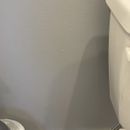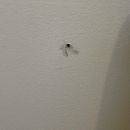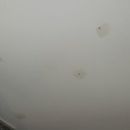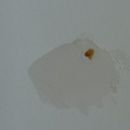Pimples in Drywall
Hi everyone, we’ve run into a drywall situation that we’ve never encountered before.
We built a single family home in Lancaster, PA (Zone 5A) and finished it Spring of 2021. This past August, 2022, we received a call from the homeowner saying drywall “pimples” have formed in his bathroom. They appear to be all over the place: high on walls, low on walls, on the ceiling, interior walls, exterior walls, etc. We pushed a screwdriver through one assuming it was a kind of screw pop, but there was no screw and black dust (sounds like mold, I know) appeared. We cut out the black portion and added drywall compound. The next day, brown spots were present.
Has anyone seen this “pimple-like” effect before?
Assuming this is a mold/mildew related issue, why would these form at different areas with no correlation between the surfaces (except they are in the bathroom)?
We tested the vent fan (located in the shower) and inspected the insulation in the exterior walls and ceiling. Everything appears to be functioning fine.
Thanks, I appreciate the assistance.
GBA Detail Library
A collection of one thousand construction details organized by climate and house part














Replies
That is an interesting puzzle. It does sound like mold (or fungus) is a likely culprit, but I wouldn't expect to see the brown staining after patching. Bathrooms usually have elevated humidity compared to the rest of the house, which could be a factor, but that also means they are supposed to have moisture-resistant drywall which has additional compounds compared to regular drywall. Do you have a mold lab near you?
Thanks for the input Michael. I agree the bathrooms have elevated humidity levels and according to our images during construction, there is moisture-resistant drywall installed. I'll check in with our local lab to confirm, but even if it is mold...I'm having a hard time understanding how it would form in the way it did and re-form so quickly (less than 24 hours). Any previous experience with something like that?
Kent, I don't recall seeing mold form or re-form like that. Do you have access to the back side of any of the drywall? If not, I would cut out a section and see what the back of the sheet looks like. I think Bill might be right in #5 below--it could be more of a bulk water issue. The brown color I've seen before when leaks result in tannins leaching out of wood, or fiberglass insulation.
I'd try to look at the back side of the drywall from the attic. That will tell you how deep the issue is, and potentially where it's coming from.
Hopefully they are using the fan. Comb over other bathrooms to see if this is happening there also.
Hi mdhomeowner, the issue seems to be isolated only to this particular bathroom. I'll double check the ceiling again and see if there are more clues or additional expansion. Thanks
My guess would be some kind of water runoff. I don't think mold would grow into your patches so quickly, and I would expect black, not brown, for mold. That brown makes me think "rust" or "sap". I did have one job where there was a roof leak over some stained T+G ceiling boards, and the water ran down the T+G, picked up some of the stain from the wood, then dripped onto the floor and stained the carpet brown from the stain. That was a screwy problem (and, BTW, it was a cat who noticed the leak and "told" everyone about it).
If it is a mold problem, I'd suggest a coat of Zinsser's mold proof primer. That stuff has worked well for me in the past over moldy roof sheathing in attics. All you have to do is clean off the worst of the "fuzzy" mold, then paint over what is left with the primer. It seals the old stuff, and has a mold killing agent in it to prevent future growth. That might help you to get this problem to stop recurring if it ends up being mold.
Bill
Thank you Bill, Michael and mdhomeowner. I appreciate your feedback and I'll explore this more and be in touch with any new developments.
We went to the home to further investigate. This time there were 8-10 new "pimples" formed. Again, not only on the ceiling, but on interior and exterior walls. The only common denominator is in the bathroom where the shower is located.
The moisture meter revealed no anomaly and the drywall was at 13.9% even after the client had taken a shower just prior to our arrival. Flir tool revealed no issues and all insulation was at the appropriate depth with typical air sealing. We pulled insulation back in the attic and found no water marks, drywall was at 11% on top and most of the "pimples" are between rafters, leading me to think it wasn't tannins or sap. We did take a sample to send to a local lab for testing and when I cut out the spot, a stone-like substance dropped out (see "Image 1"). I went to another location and found the exact same thing at another "pimple". There appears to be stones in the drywall...between the paper backings...that are pushing through. Assumedly due to the increased heat and moisture from the shower (See "Image2" and "Image3").
At this point we've contacted our supplier to investigate further, as it seems like a manufacturing issue, but has anyone heard of this before? Stone-like materials embedded between the paper facings of the drywall?
And yes, I understand it's called sheetROCK for a reason, but this seems a bit extreme. ;)
Thanks for following up. That certainly is interesting and I hope the manufacturer can help you and the homeowner out.
In the metal casting world, those would be called "inclusions", and are a type of manufacturing defect. I think you're probably right that you got a bad batch of drywall. Unfortunately, that probably means your only real solution is to rip out the bad stuff and replace it with new material.
Bill
I agree that "inclusions" is a good term for the "stones." My guess would be that some of the drywall constituents were not fully hydrated during the manufacturing process and that they subsequently hydrate and cure (and expand) after installation, especially in the damp bathroom. Or, they could be other minerals that are scavenging gases from the air for their formation. Sort of like some of the pozzolans used in concrete that scavenge CO2 from the air to form carbonates (this is good), or sulfur being scavenged from the air to form sulfates (generally bad). Many of these processes are accelerated by warm and/or damp conditions, so would happen faster in a bathroom environment. A recent famous example of the reverse of this process is the contaminated Chinese drywall a few years back that was releasing corrosive sulfur compounds into the indoor environments. I almost got a piece of that giant class-action lawsuit, but no such luck.
The bad news is, if this is a contamination or other drywall manufacturing issue, then all of the same type of drywall used in the house may experience this issue over time. If this is a production built house, entire neighborhoods can be affected. Lab testing can probably identify the composition of the inclusions and might suggest the mechanism causing them to form. Replacing the affected drywall is likely, and if the problem is more widespread, then the lawyers get involved.